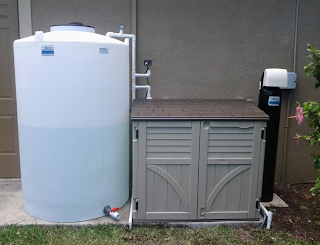Whole-House vs. Point of Use System
While all reverse osmosis systems filter water using the same fundamental technology, you’ll find two distinct types of reverse osmosis systems.
Whole House Systems
Whole house systems—sometimes also called point of entry systems treat water at the point it enters your home from the main water line. These systems are great for homes using well water or rain water or homes with contaminants in the water undesirable not just for drinking and cooking but for bathing and other water uses.
Whole-house reverse osmosis systems can cost anywhere from $750 to $7,500 depending on the size of your home. The cost is high because these systems must be fully installed to the mainline of your home, which is a much more complex process than simply disconnecting a faucet.
Point of Use Systems
Point of use systems treat water at the “point of use”, usually a sink faucet. These systems are great because they treat the water right where you need it and don’t treat water used for showering, washing clothes and lawn care if you don’t need it. This extends filter life and wear on equipment.
Reverse osmosis filters installed directly on faucets can sometimes be slow, and the attachment can be quite bulky. Point of use systems also include undersink filters which treat water either instantly with tankless filter systems or which fill up a large tank that stores treated water under your sink to be ready when you need it. This helps keep the look and size of your faucet manageable and keeps your water pressure nice and strong.
Point of use systems can cost anywhere from $150 to $1,500 depending on the type (countertop, under-sink with tank or tankless) and the complexity of installation.
Commercial Reverse Osmosis System Cost
A commercial reverse osmosis system for use in a commercial space or in a large residential space may be much more expensive. These commercial systems must be much higher capacity to meet the needs of filtering and dispensing a large amount of water from multiple points of use, especially for restaurants, hotels and breweries. Commercial systems can cost anywhere from $1,000 to $20,000 with an additional installation cost of $500 to $2,000.
Reverse Osmosis System Installation Costs
While some reverse osmosis systems are designed to be user-friendly to install with easy-to-follow DIY instructions, others require a complex knowledge of plumbing and would not be suitable for the average homeowner. It would typically be best to hire a qualified plumber for these systems.
Countertop systems and some under-sink installs can be quick and easy, while other under-sink systems (and certainly any whole home system) will likely require a plumber and incur an installation installation cost. Installation costs vary with the type of system but can run anywhere from $100 to $800 or more depending on the type of system. Complex whole home installs could be even more costly, and any price is likely to vary based on location and other factors.
Factors Affecting Reverse Osmosis System Costs
The cost of a reverse osmosis system can be affected by a number of factors. Our estimates are rough—always add extra to your budget.
Size and Type
The price of reverse osmosis systems will vary depending on the size and type of the system. Countertop units can be just a few hundred dollars while under-sink units may run between $300 and $800. For $1,000 higher, you can install a whole-house system to treat all the water right where it enters your home on the mainline. Every faucet, showerhead and icemaker in your home can be supplied with filtered water using a whole-house system.
Filtration Process and NSF Certification
While all reverse osmosis systems use a semi-permeable membrane to filter microscopic contaminants from your water, some systems feature more intensive filters than others. The quality of the filtration system will often be reflected in the National Sanitation Foundation (NSF) certification rating which guarantees the product filters out one or more specific contaminants.
The NSF standards for reverse osmosis filters which cover common contaminants and impurities present in and capable of filtration are: 42, 53, 58, 401 and P473.
Efficiency
Reverse osmosis is a simple, reliable and highly effective method to produce safe drinking water. When it works properly, it can remove virtually all the impurities in water, leaving only pure, fresh drinking water. Therefore, the efficiency of a reverse osmosis system is a measurement of how quickly the system can produce filtered water and how much water has been lost in the process. Most systems can produce over 2 gallons of filtered water per hour, but their efficiency depends on the RO membrane they use.
Brand
Let’s face it: filtering water is expensive. But the last thing you want is to go through the same headache of replacing your system every few years. Certain water filters on the market can last more than a decade before they need to be replaced, which is an investment worth making.
If you’re prepared to gamble on a newer product, you could save yourself a few hundred dollars—make sure the manufacturer has all the proper certifications and the system you choose has a good warranty.
Additional Features
Common add-ons include extra pumps to help boost pressure and increase both the efficiency and the flow rate of the system. These are especially common with tank systems that need to pump water back out of a tank at an appropriate pressure. Another common additional feature is a remineralization process which helps add important-for-humans minerals that the reverse osmosis process removes.
The remineralization also re-balances the pH of the water to the correct alkalinity which may reduce corrosion of your home’s pipes.
 |
| Whole house reverse osmosis system |
No comments:
Post a Comment